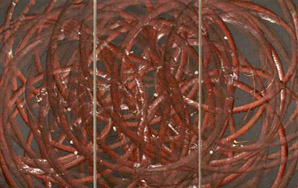Aaron Young: Bad Ass Art
Most people who’ve had an art history course, or who have ever been to a modern art museum, may remember Fountain (or one of its many iterations) and found themselves walking away from it thinking “if it was really art” in the first place. But what Fountain proposes, though, is not so much “is it…

When Marcel Duchamp anonymously submitted an upside down urinal to an art competition in 1917 and signed it “R. Mutt,” he was being a real bad ass. Can you imagine being on the selection committee for that competition? Painting after painting after boring painting (yawn) and then – there it is – a urinal! Duchamp was a bad ass in the sense that he was creating something fresh, a new possibility for art out of, what, a urinal. That’s right – enough with high painting and all the rest, because Fountain was as much a prank as it was a test. But a test of what, exactly?
Most people who’ve had an art history course, or who have ever been to a modern art museum, may remember Fountain (or one of its many iterations) and found themselves walking away from it thinking “if it was really art” in the first place. But what Fountain proposes, though, is not so much “is it art” and more “how bad ass can your art be.” But can anybody be a bad ass after Duchamp? I mean, how many more art pranks are left?
Aaron Young – one of the hottest contemporary artists working today – takes Duchamp’s art-as-test formula and cranks the gas way up. I first came across Young’s work back in 2008 when I was an intern at Deitch Projects, a downtown New York gallery. He was part of an exhibition curated by Nikki Vassell titled “Substraction, ” a show about a group of artists working in New York who mixed the Duchampian idea of art-as-test with the electric feel of Jackson Pollock’s vast, abstract canvases. There was graffiti by Sterling Ruby, bird shit by Dan Colen and Kristin Baker’s race cars, but in my mind Aaron Young’s bikes stood out the most.
With Burnout (Locals, Red Wings I), 2008, you roll up to a dark brown and maroon colored aluminum triptych that’s cluttered with concentric circles that spin into and out of one another. At first glance, there’s nothing immediately arresting about the work – just a bunch of circles (worms, perhaps?) on a metal canvas. But the second you learn that the maroon circles were produced by motorcycles that drove all around the canvas, literally burning through the top layer of paint to reveal the circles underneath, the excitement sets in. I remember telling gallery goers about Young’s paintings and they didn’t seem interested until I told them about the motorcycle performances. And just like that – performance changed everything.

As a student at the San Francisco Art Institute, Young was elevated to badass status when he staged a performance in which a motorcycle circled the floor of a gallery, and the Museum of Modern Art scouped the video up immediately. In 2007, Young staged Greeting Card at the Park Avenue Armory, and it seemed by that point he had really perfected his methods. During that high-octane performance, huge slabs of specially painted metal canvas were laid out on the floor, and Young conducted a team of motorcyclists who revved their engines, burned rubber and skidded all over to reveal the fluorescent orange hue hidden under a layer of black paint. The motorcycles aren’t just riding on the canvas, though – they’re “banging” the hell out of it for all. Now there’s a high energy gesture!
Performance theorist Peggy Phelan has written that performances are live, they happen right now, they can’t be photographed or documented. A photograph of a performance is just that – a photograph of a performance. You don’t feel the jive of the music by looking at the party photo. But though Young’s paintings are relics of a performance, like photographs, I bet that if you sniffed close enough, you might still be able to smell the exhaust. Knowing the painting process reanimates the paintings so much that you can’t think of the painting without thinking about the performance.
What Young’s work does is to make contemporary art accessible to all. You don’t have to know about Pollock or Duchamp or Frankenthaler to see that Young is a total badass. Young’s art engages with the language of street culture that we are all familiar with – motorcycles, parking meters, bikes, sunglasses, police lines, and bodybuilding. It’s an art of the street, taking what we see everyday and making it even more vibrant. In that way, he plugs into a long line of artists who have taken their work out of the gallery and into the street, and sometimes from the street and into the gallery.

There’s something about Aaron Young’s work, though, that I’ve been trying to pin-point, and now I think I’ve found it: it is unapologetically heterosexual and relentlessly masculine. Masculinity as spectacle. All those guys riding around on motorcycles, “banging” the canvas, leaving only a trace of paint-jizz. It’s hot! Even the artist himself, with his beard and cigarettes and tattoos, is ridiculously sexy, and his high-testosterone art only makes him sexier. One could say that the Warholian strand of pop art, for instance, was a touch gayer in its valorization of celebrities, glamour, fashion, divas, and hot men. But with Young’s art, just to make the comparison, we get the artist as “dude” who loves hot chicks, drinking beers, pot, and tooling around on his motorcycle. It’s not an art of the fey but an art of the butch. ![]()

